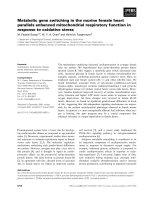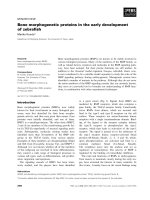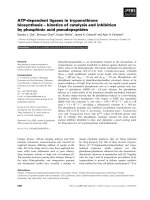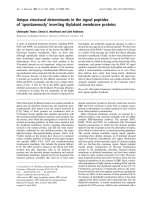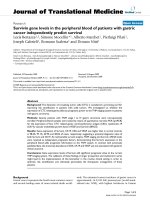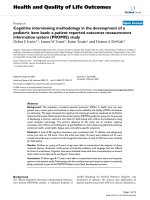báo cáo hóa học:" Survivin gene levels in the peripheral blood of patients with gastric cancer independently predict survival" doc
Bạn đang xem bản rút gọn của tài liệu. Xem và tải ngay bản đầy đủ của tài liệu tại đây (367.12 KB, 8 trang )
BioMed Central
Page 1 of 8
(page number not for citation purposes)
Journal of Translational Medicine
Open Access
Research
Survivin gene levels in the peripheral blood of patients with gastric
cancer independently predict survival
Loris Bertazza
1,2
, Simone Mocellin*
1
, Alberto Marchet
1
, Pierluigi Pilati
1
,
Joseph Gabrieli
1
, Romano Scalerta
1
and Donato Nitti
1
Address:
1
Department of Oncological & Surgical Sciences, Section of Clinica Chirurgica 2, University of Padova, via Giustiniani 2, 35128, Padua,
Italy and
2
Istituto Oncologico Veneto IRCCS, via Gattamelata 64, 35128, Padua, Italy
Email: Loris Bertazza - ; Simone Mocellin* - ; Alberto Marchet - ;
Pierluigi Pilati - ; Joseph Gabrieli - ; Romano Scalerta - ;
Donato Nitti -
* Corresponding author
Abstract
Background: The detection of circulating tumor cells (CTC) is considered a promising tool for
improving risk stratification in patients with solid tumors. We investigated on whether the
expression of CTC related genes adds any prognostic power to the TNM staging system in patients
with gastric carcinoma.
Methods: Seventy patients with TNM stage I to IV gastric carcinoma were retrospectively
enrolled. Peripheral blood samples were tested by means of quantitative real time PCR (qrtPCR)
for the expression of four CTC related genes: carcinoembryonic antigen (CEA), cytokeratin-19
(CK19), vascular endothelial growth factor (VEGF) and Survivin (BIRC5).
Results: Gene expression of Survivin, CK19, CEA and VEGF was higher than in normal controls
in 98.6%, 97.1%, 42.9% and 38.6% of cases, respectively, suggesting a potential diagnostic value of
both Survivin and CK19. At multivariable survival analysis, TNM staging and Survivin mRNA levels
were retained as independent prognostic factors, demonstrating that Survivin expression in the
peripheral blood adds prognostic information to the TNM system. In contrast with previously
published data, the transcript abundance of CEA, CK19 and VEGF was not associated with patients'
clinical outcome.
Conclusions: Gene expression levels of Survivin add significant prognostic value to the current
TNM staging system. The validation of these findings in larger prospective and multicentric series
might lead to the implementation of this biomarker in the routine clinical setting in order to
optimize risk stratification and ultimately personalize the therapeutic management of these
patients.
Background
Gastric cancer represents the fourth most common cancer
and second leading cause of cancer-related death world-
wide. The estimated current incidence of gastric cancer is
approximately 16.2/100 000 persons/year (world stand-
ardized rate, WSR), with highest incidences in Eastern
Published: 22 December 2009
Journal of Translational Medicine 2009, 7:111 doi:10.1186/1479-5876-7-111
Received: 24 August 2009
Accepted: 22 December 2009
This article is available from: />© 2009 Bertazza et al; licensee BioMed Central Ltd.
This is an Open Access article distributed under the terms of the Creative Commons Attribution License ( />),
which permits unrestricted use, distribution, and reproduction in any medium, provided the original work is properly cited.
Journal of Translational Medicine 2009, 7:111 />Page 2 of 8
(page number not for citation purposes)
Asia, Eastern Europe and South America [1]. At present
the only prognostic system routinely employed for the
management of gastric cancer patients is based on the
International Union Against Cancer Tumor-Node-Metas-
tasis (TNM) staging system [2], in which the degree of
tumor penetration (pT) and nodal status (pN) [3] are the
two main prognostic indicators in patients without dis-
tant metastatic disease. Patients in early stages are consid-
ered candidates for cure by surgery. However, 50% of
gastric cancer patients suffer from tumor relapses even
after radical surgery [4,5]. Thus, the current staging system
does not seem to accurately predict individual patient risk
of cancer recurrence. Indeed this classification identifies
broad categories with significantly different prognostic
subgroup within each stage, which make this system sub-
optimal for a personalized therapeutic approach. This is
exemplified by the fact that some patients currently classi-
fied as "low-risk" are not submitted to adjuvant therapy,
although they do experience disease relapse. Vice versa,
some patients currently undergoing adjuvant therapy
because of "high risk" TNM classification, would not need
this treatment [6]. In order to address this issue and
improve upon the prognosis of patients, new parameters
reliably predicting patients' outcome are urgently needed.
Patients who had undergone potentially curative surgeries
retain the risk of recurrence that originates from micro-
scopic tumor residues known as minimal residual disease
(MRD). MRD can affect different body compartments,
including the bone marrow, lymph nodes and peripheral
blood [7]. In recent years, several studies have focused on
the detection of circulating tumor cells (CTC) with respect
to their clinical implications for patients with gastric can-
cer. As a result, quantitative real time polymerase chain
reaction (qrtPCR) and variations of this technique, which
is considered to be the most sensitive method for evaluat-
ing gene expression, have been used in the detection of
tumor markers that indicate the presence of CTC in the
blood [8].
In the current analysis, we aimed to profiling the periph-
eral blood of 70 patents affected with gastric adenocarci-
noma by using qrtPCR. We tested four biomarkers, two of
the presence, ad two of the aggressiveness of the tumor,
and one of these, the Survivin, add independent prognos-
tic power to the TMN staging system. This might allow for
a better stratification of patient's risk and thus a better
therapeutic management, especially in the adjuvant set-
ting.
Methods
Patients
In this study we enrolled 70 patients (39 men, 31 women;
age range 28 - 90 years, median age 68 years) who under-
went surgery (total or partial gastrectomy) for histologi-
cally proven gastric carcinoma between October 1998 and
November 2007, and for whom a peripheral blood sam-
ple was available. The study, which is in compliance with
the Helsinki Declaration, was approved by the Local Ethi-
cal Committee of the University of Padova (approval
number: 70/2006). Written informed consent regarding
the use of biological specimens for investigational pur-
poses was obtained from all patients. At the time of the
analysis, 33 (47.1%) were alive whereas 37 (52.9%) had
died. Median follow-up was 15 months (range: 6-119
months). Median survival was 25 months. Tumor charac-
teristics are summarized in Table 1. The depth of tumor
invasion (T category), extent of lymph node metastasis (N
category) and macroscopic metastasis (M category) were
categorized according to the UICC TNM staging system.
Cell lines
The human gastric carcinoma cell line NCI-N87, obtained
from the American Type Culture Collection (Manassas,
USA), was incubated in RPMI-1640 medium (Invitrogen -
Gibco, Carlsbad, CA, USA) containing 10% fetal calf
serum (Euroclone - Celbio, Pero, MI), 10 mM Hepes, 1
mM Sodium Pyruvate (Sigma-Aldrich, St. Louis, MO), at
37°C in 5% CO
2
.
NCI-N87 is a gastric carcinoma cell line derived from a
liver metastasis of a well differentiated carcinoma of the
stomach taken prior to cytotoxic therapy. According to the
manufacturer's datasheet, cells express the surface glyco-
proteins carcinoembryonic antigen (CEA).
Table 1: Patients and tumor characteristics.
Parameters N (%)
Patients
all 70 (100.0)
male 39 (55.7)
female 31 (44.3)
Age (years)
≤ 65 21 (30.0)
> 65 49 (70.0)
Location
multicentric 5 (7.1)
upper third 11 (15.7)
middle third 19 (27.1)
lower third 35 (50.0)
TNM stage
I (IA + IB) 10 (14.3)
II 14 (20.0)
III (IIIA + IIIB) 19 (27.1)
IV 27 (38.6)
Journal of Translational Medicine 2009, 7:111 />Page 3 of 8
(page number not for citation purposes)
Cell spiking experiments
A cell spiking study was performed in order to determine
the sensitivity of this qrtPCR technique for detecting can-
cer cells in peripheral blood mononuclear cells (PBMC).
The PBMC were obtained from healthy volunteers, and
were counted and diluted 1:1 in RPMI medium. Gastric
cancer cells N87 were counted and serially diluted from 1
× 10
6
cells/milliliter to 1 cell/milliliter in the PBMC. Total
RNA was extracted and reverse- transcribed from 2 millili-
ters of each fraction. qrtPCR for two genes of interest were
then performed, as described below.
Sample collection, RNA extraction and cDNA synthesis
A 6 ml aliquot of venous blood was obtained from each
patient at the time of surgery. Sample processing was per-
formed within two hours after blood withdrawal. Sample
was centrifuged at 2000 × g for 10 minutes, and the PBMC
fraction was collected and stored in liquid nitrogen.
Frozen samples were thawed and total RNA was extracted
using the Guanidinium Thiocyanate-Phenol-Chloroform
method (Trizol Reagent, Invitrogen, Carlsbad, CA, US).
The integrity of the isolated RNA was established by qrt-
PCR analysis of the endogenous reference gene beta actin
(b-actin) as described below [9].
Total RNA (7 μg per 100 μl final reaction volume) was
reverse-transcribed using random primers and Multi-
Scribe Reverse Transcriptase (High-Capacity cDNA reverse
transcription kit, Applied Biosystems, Foster City, CA,
USA). The reaction mixture was incubated for 10 minutes
at 25°C, then at 37°C for 120 minutes. cDNA was stored
at -80°C until use.
Real-time quantitative polymerase chain reaction
The transcriptional levels of four genes (i.e., carcinoem-
bryonic antigen [CEA], cytokeratin-19 [CK19], Survivin
and vascular endothelial growth factor [VEGF]) were
measured in the peripheral blood of patients by means of
quantitative real time PCR (qrtPCR) using the relative
quantification method (2
-ΔΔCt
method) [10,11]. Using the
2
-ΔΔCt
method the data are presented as the fold-change in
gene expression normalized by a reference gene and rela-
tive to a calibrator sample. The purpose of the normaliza-
tion process is to adjust the value representing the
transcriptional levels of each gene by the amount of
mRNA present in each sample: this is usually obtained by
dividing the expression levels of each gene of interest by
those of a reference gene (also called "housekeeping"
gene). Housekeeping genes are expressed constitutively
and - ideally - are not affected by experimental manipula-
tions: therefore, they should approximately reflect the
total amount of mRNA tested in each sample [12]. As the
reference gene in this study we used beta-actin, one of the
most commonly used housekeeping genes.
In a relative quantification PCR study, the so called "cali-
brator" is represented by the gene expression of a chosen
sample by which the expression profile of each sample of
interest is adjusted: this approach enables the investigator
to compare the expression profile of the samples of inter-
est with each other in terms of their fold-change with
respect to a single sample (the calibrator).
Usually, the calibrator is an untreated sample (e.g. in a
functional study), a sample at time zero (e.g. in a time-
course study) or any unrelated sample (e.g. healthy con-
trols in a patients study, or normal fibroblasts in a cancer
cell line study) [10]. A pool of cDNA derived from PBMC
of 20 healthy donors was used as the calibrator source in
our study. Evaluation of the 2
-ΔΔCt
indicates the fold
change in gene expression relative to the calibrator. For
the calibrator the ΔΔCt equals zero, and 2
0
equals one, so
that the fold change in gene expression relative to the cal-
ibrator equals one, by definition.
The method was validated for our experimental system by
verifying that the efficiencies of amplification of the tar-
gets and the b-actin genes were similar. TaqMan Gene
Expression Assays specific for CEA, CK19, Survivin and
VEGF were purchased from Applied Biosystems. To avoid
amplifying contaminated genomic DNA, the primer pair
was placed at the junction between two exons. The qrtPCR
assay was performed using the ABI PRISM 7300 Sequence
Detection system. The PCR reaction proceed in a mixture
(30 μl) containing 15 μl of 2× TaqMan Universal PCR
Master Mix, 1.5 μl of 20× TaqMan Gene Expression assay
(all reagents from Applied Biosystems), 12.5 μl of water
and 1 μl of cDNA template. Fifty cycles of amplification
were performed at 95°C (15 seconds) and 60°C (1
minute) and mRNA expression levels were normalized
against quantified b-actin mRNA expression for each sam-
ple.
Statistical analysis
Statistical analyses were performed using the Stat View V.
4.57 software (Abacus Concepts, London, UK) and the
StatXact V7.0.0 software (Cytel Software Corporation,
USA). The correlation between gene levels (high versus
low gene expression, as defined by the median value) and
disease TNM staging categories was assessed by using the
Cochrane-Armitage trend test. Survival curves were esti-
mated using the Kaplan-Meyer method, and univariate
survival comparisons were calculated according to the log-
rank test. The transcriptional levels of the four genes,
along with anthropometric factors and TNM stages
(according to the 5th edition of the AJCC TNM staging
system released in 1997), were utilized as independent
variables in the multivariate survival analysis, which was
performed using the Cox proportional hazards regression
model [13]. The selection of variables that significant con-
Journal of Translational Medicine 2009, 7:111 />Page 4 of 8
(page number not for citation purposes)
tribute to the predictive model was performed by stepwise
method. Probability values <5% were considered statisti-
cally significant.
Results
Cell spiking: sensitivity of qrtPCR technique
In the N87 cell line, mRNA levels of the CEA, CK19, Sur-
vivin, and VEGF genes were highly expressed (Figure 1):
therefore, this gastric carcinoma cell line represented a
valid positive control for our experiments.
To establish the detection limit (sensitivity) of the qrtPCR
technique, serial 10-fold dilutions (in PBMC) of N87 gas-
tric carcinoma cells were assayed in triplicate by qrtPCR
using CEA and Survivin as gene markers. CEA and Sur-
vivin mRNA were detected up to 1 cell/10
8
PBMC dilu-
tion: this corresponds to finding 1 to 10 malignant cells
per 10 ml of peripheral blood (data not shown).
Expression markers in blood samples
Peripheral blood samples from all 70 patients were evalu-
ated for the four gene markers. The expression was posi-
tive (higher than calibrator) in 98.6%, 97.1%, 42.9%,
38.6% of samples for Survivin, CK19, CEA, VEGF, respec-
tively (Table 2). Since Survivin and CK19 gene levels
found in nearly all patients are greater than those in
healthy controls, these findings point to a diagnostic
potential of both genes.
Moreover, if we considered the 75th percentile of Survivin
expression levels per stage, we had a significant increased
trend (p = 0.04) for stages from I to III, but not for stage
IV (Figure 2).
Survival analysis
After a mean follow up of 26 months, the median overall
survival (OS) for TNM stage I-II was not reached; the
median OS for stage III and IV was 25 and 13 months,
respectively (log-rank test P-value < 0.0001, Figure 3).
Upon univariate survival analysis, among the four genes
we have tested, only Survivin expression could identify
two patient groups with significantly different prognosis.
In fact, considering the 75th percentile of log-transformed
gene transcription levels (1.508) as the cutoff point,
median OS for high (>1.508) and low (≤1.508) Survivin
mRNA abundance were 14 and 41 months, respectively
(log-rank P-value = 0.036, Figure 4).
The multivariate survival analysis including TNM stage,
age, gender and mRNA levels of the four markers showed
that only TNM stage and Survivin mRNA levels measured
in the peripheral blood independently predict patients'
OS. The hazard ratio (HR) associated with Survivin levels
indicates the increase in risk of death for 100 fold increase
in Survivin expression (Table 3).
Since only these four independent variables were retained
by the Cox model, this analysis suggests that Survivin gene
expression can add useful prognostic information to well
established factors such as the TNM staging system.
Discussion
In this study we found that transcriptional levels of Sur-
vivin measured in the peripheral blood of patients with
gastric carcinoma independently correlate with their over-
all survival.
If validated in larger prospective studies, these results
would allow to increase the prognostic power of conven-
tional prognostic factors, which are currently embodied
by the TNM staging parameters. This is of special rele-
vance for patients with TNM stage I to III disease, for
whom optimal risk stratification is essential to identify
subjects with the highest likelihood to benefit from adju-
vant treatments.
Our findings are of particular relevance also from the
tumor biology viewpoint because the Survivin gene
encodes a key anti-apoptotic protein belonging to the
inhibitor of apoptosis protein (IAP) family. Beside being
Gene expression levels of the four genes of interest in N87 human gastric cancer cells (as measured by quantitative real time PCR: see text for details)Figure 1
Gene expression levels of the four genes of interest in
N87 human gastric cancer cells (as measured by
quantitative real time PCR: see text for details). The
natural logarithm of the expression levels is reported on the
y axis: the axis origin (0) represents the reference sample
(called calibrator) with which all experimental samples are
compared in the relative quantification method (see text for
details).
CEA CK19 Survivin VEGF
0
2
4
6
8
10
Ln Gene expression
Genes tested
Journal of Translational Medicine 2009, 7:111 />Page 5 of 8
(page number not for citation purposes)
one of the best characterized anti-apoptotic factors [14],
Survivin is the object of intense investigation due to the
fact that in adults it is selectively expressed virtually only
by cancers of different origin; moreover, its expression in
the primary tumor has been associated with worse prog-
nosis and resistance to conventional chemotherapeutics
[15]. These observations make Survivin an ideal target for
tumor-specific therapies, such as small molecule inhibi-
tors and antigen-specific immunotherapy [16].
Survivin protein expression in primary tumors, including
gastric cancer, has been investigated as a prognostic factor,
higher levels being associated with worse cancer outcome
[17]. About RNA expression, Survivin mRNA levels have
been investigated as a marker of circulating tumor cells
(CTC) in different kind of cancer, but the available data
are scarce [18,19]. In a series of 26 gastric cancer patients,
Survivin mRNA (as measured by means of ELISA-based
qrtPCR) in the peripheral blood has been reported to cor-
relate with patients' prognosis, the TNM staging being
excluded from the final mutivariable model (forcing all
variables into the Cox model) [20]. In our larger series (n
= 70), the prognostic role of Survivin blood levels is con-
firmed, although the TNM staging remains a significant
prognostic factor in the final multivariable model (using
the stepwise mode for variable selection). Despite the sig-
nificant association with patients' prognosis, Survivin
mRNA levels did not increase across all four TNM stages:
the trend for increased transcriptional abundance was in
fact demonstrated only in patients with stage I to III dis-
ease (Figure 2). This finding might depends upon the low
sample sizes of the single TNM stages (and the consequent
low statistical power) but might also indicates that Sur-
Table 2: Transcriptional levels of four prognostic markers in the peripheral blood of patients with gastric cancer.
Marker Above calibrator (%)* Below calibrator (%)* Undetectable (%)
Survivin 69 (98.6) 1 (1.4) 0 (0.0)
CK19 68 (97.1) 2 (2.9) 0 (0.0)
CEA 30 (42.9) 21 (30.0) 19 (27.1)
VEGF 27 (38.6) 43 (61.4) 0 (0.0)
* Gene expression levels were measured by quantitative real time PCR: using the relative quantification method, samples were classified as above or
below the levels found in the calibrator (pooled peripheral blood samples from healthy donors).
Survivin gene levels measured in the peripheral blood of 70 patients with TNM stage I to IV gastric cancerFigure 2
Survivin gene levels measured in the peripheral
blood of 70 patients with TNM stage I to IV gastric
cancer. The trend test analysis shows a significant increase
in Survivin transcriptional levels across patients with stage I
to III gastric cancer (trend test P-value = 0.04). For each col-
umn is reported the mean ± SD.
I II III IV
0,0
0,4
0,8
1,2
1,6
2,0
2,4
1.12±0.16
1.77±0.40
1.18±0.23
n=27n=19
n=14
ln 2
-ΔΔCt
Survivin gene expression
TNM stage
Trend test p=0.04
n=10
1.05±0.22
Overall survival for TNM stage I-II, III and IV for all patients (log-rank test P-value < 0.0001)Figure 3
Overall survival for TNM stage I-II, III and IV for all
patients (log-rank test P-value < 0.0001).
Time (months)
Cum Survival
log-rank P-value < 0.0001
stage I-II
stage III
stage IV
Journal of Translational Medicine 2009, 7:111 />Page 6 of 8
(page number not for citation purposes)
vivin plays a role in locoregional and not in distant meta-
static disease (where other genes could be more relevant,
as recently reported [21]).
Unlike other studies [9,22-26], the levels of CK19 and
CEA did not correlate with patients survival in our series,
either on univariable (data not shown) or multivariable
survival analysis: this might depend upon several factors.
First of all, the inclusion in our multivariable analysis
(with a stepwise mode of variable selection) of a marker
not considered by other Authors makes any comparison
unfeasible.
Of note, some positive reports only use univariable sur-
vival analysis, which jeopardizes the reliability and repro-
ducibility of their results, once adjustment for well
established prognostic factors (i.e. TNM stages) were
implemented [9,25,27,28]. Moreover, in line with our
results other investigators do report lack of association
between cytokeratins positive cells presence and progno-
sis [29] (Table 4).
These conflicting data might depend on the fact that CK19
and CEA are markers of CTC presence but not necessarily
of CTC ability to metastasize: in fact, it is well accepted
that only a subset of CTC has the biological potential of
giving rise to metastatic deposits, while most CTC ulti-
mately die without being harmful for the host [7]. Accord-
ingly, markers of CTC "aggressiveness" such as Survivin
might reveal to be more informative in terms of correla-
tion with patients' prognosis.
Of note, in the present study the mRNA abundance of Sur-
vivin and CK19 was always greater than that found in
healthy controls except for one and two cases, respec-
tively. This underscores the importance of using a quanti-
tative method (qrtPCR) that enabled us to stratify patients
risk on a continuous scale, whereas standard PCR would
have classified virtually all patients as positive. On the
other side, this finding - which to the best of our knowl-
edge has never been reported before - suggests that these
genes might be exploited also for diagnostic purposes,
although a dedicated study specifically designed for this
aim is warranted.
As a final consideration, we would like to observe that
PCR-based methods do not allow to identify the cell
source of the measured markers: in fact, all these methods
require the lysis of the cells harvested from the peripheral
blood of patients in order to extract the mRNA used to
assess the expression of target genes. Besides CTC, other
potential sources of PCR-detected genes are PBMC, circu-
lating endothelial cells (CEC), bone marrow derived cir-
culating stem cells as well as skin cells (e.g. keratinocytes,
fibroblasts, melanocytes) contaminating the sample dur-
ing blood withdrawal. Nevertheless, CTC are likely to be
the principal cell source for Survivin as its expression is
very limited in normal adult tissues and is instead mainly
restricted to malignant cells [30]. In this regard, cytomet-
ric methods are less prone to false positive results, as they
imply antibody-based cell sorting followed by cytological
identification of tumor cells that precedes their pheno-
typic characterization [31].
Kaplan-Meier survival curves of patients with high (> 75th percentile) or low (< 75th percentile) transcriptional levels of Survivin measured in the peripheral bloodFigure 4
Kaplan-Meier survival curves of patients with high (>
75th percentile) or low (< 75th percentile) transcrip-
tional levels of Survivin measured in the peripheral
blood. Log-rank test P-value = 0.036.
Time (months)
Cum Survival
low survivin
high survivin
log-rank P-value = 0.036
Table 3: Multivariate survival analysis of 70 patients with gastric
cancer.
Covariates HR 95% CI P-value
Lower limit Upper limit
TNM stage I 1 (reference) - - -
stage II 1.20 1.01 1.45 0.048
stage III 1.34 1.05 1.70 0.017
stage IV 3.17 1.38 6.77 0.004
Survivin* 1.34 1.14 1.53 < 0.001
HR: hazard ratio; CI: confidence interval; * the HR associated with
Survivin levels indicates the increase of death risk for 100-fold
increase in Survivin expression.
Journal of Translational Medicine 2009, 7:111 />Page 7 of 8
(page number not for citation purposes)
Conclusions
Gene expression levels of Survivin add significant prog-
nostic value to the current TNM staging system of patients
with gastric carcinoma. The validation of these findings in
larger prospective series might lead to optimize the risk
stratification and ultimately to personalize the therapeutic
management of these patients.
Competing interests
The authors declare that they have no competing interests.
Authors' contributions
LB conceived the study design, handled biological sam-
ples, performed qrtPCR analysis and drafted the manu-
script. SM conceived the study design, performed
statistical data analysis and drafted the manuscript. JG,
AM and PP participated in the design of the study and col-
Table 4: Selected series analyzing the prognostic role of circulating tumor cells (CTC) in patients with gastric cancer.
Author Year Ref. Patients Method Survival analysis Markers Findings
Koga T et. al. 2008 [9] 101 Quantitative RT-
PCR
Univariate CK18, CK19,
CK20, CEA
CK19 is the better
marker, and is usable
to estimate prognosis
or for adjuvant
treatment
Yie SM et. al. 2008 [20] 26 (gastric cancer) RT-PCR ELISA Multivariate Survivin Status of Survivin-
expressing CTC is a
strong and
independent predictor
for recurrence
Hiraiwa K et. al. 2008 [22] 44 (gastric cancer) CellSearch system Multivariate CD45 (-) cells vs
CK (+) cells
CTSs significantly
correlated with
advanced tumor stage
Illert B et. al. 2005 [23] 70 Quantitative RT-
PCR
Multivariate CK20 CK20 is an
independent
prognostic marker
Yeh KH et. al. 1998 [24] 34 Nested quantitative
RT-PCR
Univariate CK19 CK19 expressing CTC
are associated with
poor prognosis
Seo JH et. al. 2005 [25] 46 Quantitative RT-
PCR
Not performed CEA CEA mRNA is
significantly correlated
with clinical
recurrence
Wu CH et. al. 2006 [26] 42 Quantitative RT-
PCR
Not performed hTERT, CK19,
CK20, CEA
CEA mRNA is
correlated with higher
risk of postoperative
recurrence/metastasis
Uen YH et. al. 2006 [27] 52 Quantitative RT-
PCR
Univariate c-MET, MUC1 c-Met and
MUC1mRNA
significantly correlate
with prognosis
Mimori K et. al. 2008 [28] 810 Quantitative RT-
PCR
Univariate MT1-MMP MT1-MMP is an
independent factor for
determining
recurrence and distant
metastasis
Pituch-Noworolska
A et. al.
2007 [29] 57 Flow cytometry Univariate CD45 (-) cells vs
CK (+) cells
The presence of CK
(+) cells is of no
prognostic value
Publish with Bio Med Central and every
scientist can read your work free of charge
"BioMed Central will be the most significant development for
disseminating the results of biomedical research in our lifetime."
Sir Paul Nurse, Cancer Research UK
Your research papers will be:
available free of charge to the entire biomedical community
peer reviewed and published immediately upon acceptance
cited in PubMed and archived on PubMed Central
yours — you keep the copyright
Submit your manuscript here:
/>BioMedcentral
Journal of Translational Medicine 2009, 7:111 />Page 8 of 8
(page number not for citation purposes)
lected the clinical data of patients. RS handled samples
collection and storage until RNA extraction. DN coordi-
nated the study and participated in manuscript writing
and editing. All authors read and approved the final ver-
sion of the manuscript.
References
1. de Vries AC, Meijer GA, Looman CW, Casparie MK, Hansen BE, van
Grieken NC, Kuipers EJ: Epidemiological trends of pre-malig-
nant gastric lesions: a long-term nationwide study in the
Netherlands. Gut 2007, 56:1665-1670.
2. Greene FL, Sobin LH: The TNM system: our language for can-
cer care. J Surg Oncol 2002, 80:119-120.
3. Aurello P, D'Angelo F, Rossi S, Bellagamba R, Cicchini C, Nigri G,
Ercolani G, De Angelis R, Ramacciato G: Classification of lymph
node metastases from gastric cancer: comparison between
N-site and N-number systems. Our experience and review of
the literature. Am Surg 2007, 73:359-366.
4. Goldberg RM, Fleming TR, Tangen CM, Moertel CG, Macdonald JS,
Haller DG, Laurie JA: Surgery for recurrent colon cancer: strat-
egies for identifying resectable recurrence and success rates
after resection. Eastern Cooperative Oncology Group, the
North Central Cancer Treatment Group, and the South-
west Oncology Group. Ann Intern Med 1998, 129:27-35.
5. Marrelli D, De Stefano A, de Manzoni G, Morgagni P, Di Leo A,
Roviello F: Prediction of recurrence after radical surgery for
gastric cancer: a scoring system obtained from a prospective
multicenter study. Ann Surg 2005, 241:247-255.
6. Janunger KG, Hafstrom L, Glimelius B: Chemotherapy in gastric
cancer: a review and updated meta-analysis. Eur J Surg 2002,
168:597-608.
7. Bertazza L, Mocellin S, Nitti D: Circulating tumor cells in solid
cancer: tumor marker of clinical relevance? Curr Oncol Rep
2008, 10:137-146.
8. Vogel I, Kalthoff H: Disseminated tumour cells. Their detection
and significance for prognosis of gastrointestinal and pancre-
atic carcinomas. Virchows Arch 2001, 439:109-117.
9. Koga T, Tokunaga E, Sumiyoshi Y, Oki E, Oda S, Takahashi I, Kakeji Y,
Baba H, Maehara Y: Detection of circulating gastric cancer cells
in peripheral blood using real time quantitative RT-PCR.
Hepatogastroenterology 2008, 55:1131-1135.
10. Livak KJ, Schmittgen TD: Analysis of relative gene expression
data using real-time quantitative PCR and the 2(-Delta Delta
C(T)) Method. Methods 2001, 25:402-408.
11. Mocellin S, Rossi CR, Pilati P, Nitti D, Marincola FM: Quantitative
real-time PCR: a powerful ally in cancer research. Trends Mol
Med 2003, 9:189-195.
12. Sturzenbaum SR, Kille P: Control genes in quantitative molecu-
lar biological techniques: the variability of invariance. Comp
Biochem Physiol B Biochem Mol Biol 2001, 130:281-289.
13. Ahmed FE, Vos PW, Holbert D: Modeling survival in colon can-
cer: a methodological review. Mol Cancer 2007, 6:15.
14. Altieri DC: Molecular circuits of apoptosis regulation and cell
division control: the survivin paradigm. J Cell Biochem 2004,
92:656-663.
15. Yamamoto H, Ngan CY, Monden M: Cancer cells survive with
survivin. Cancer Sci 2008, 99:1709-1714.
16. Altieri DC: Survivin, cancer networks and pathway-directed
drug discovery. Nat Rev Cancer 2008, 8:61-70.
17. Wang TT, Qian XP, Liu BR: Survivin: potential role in diagnosis,
prognosis and targeted therapy of gastric cancer. World J Gas-
troenterol 2007, 13:2784-2790.
18. Shen C, Hu L, Xia L, Li Y: The detection of circulating tumor
cells of breast cancer patients by using multimarker (Sur-
vivin, hTERT and hMAM) quantitative real-time PCR. Clin
Biochem 2009, 42:194-200.
19. Yie SM, Lou B, Ye SR, He X, Cao M, Xie K, Ye NY, Lin R, Wu SM,
Xiao HB, Gao E: Clinical significance of detecting survivin-
expressing circulating cancer cells in patients with non-small
cell lung cancer. Lung Cancer 2009, 63:284-290.
20. Yie SM, Lou B, Ye SR, Cao M, He X, Li P, Hu K, Rao L, Wu SM, Xiao
HB, Gao E: Detection of survivin-expressing circulating cancer
cells (CCCs) in peripheral blood of patients with gastric and
colorectal cancer reveals high risks of relapse. Ann Surg Oncol
2008, 15:
3073-3082.
21. Psaila B, Lyden D: The metastatic niche: adapting the foreign
soil. Nat Rev Cancer 2009, 9:285-293.
22. Hiraiwa K, Takeuchi H, Hasegawa H, Saikawa Y, Suda K, Ando T,
Kumagai K, Irino T, Yoshikawa T, Matsuda S, et al.: Clinical signifi-
cance of circulating tumor cells in blood from patients with
gastrointestinal cancers. Ann Surg Oncol 2008, 15:3092-3100.
23. Illert B, Fein M, Otto C, Cording F, Stehle D, Thiede A, Timmermann
W: Disseminated tumor cells in the blood of patients with
gastric cancer are an independent predictive marker of poor
prognosis. Scand J Gastroenterol 2005, 40:843-849.
24. Yeh KH, Chen YC, Yeh SH, Chen CP, Lin JT, Cheng AL: Detection
of circulating cancer cells by nested reverse transcription-
polymerase chain reaction of cytokeratin-19 (K19) possible
clinical significance in advanced gastric cancer. Anticancer Res
1998, 18:1283-1286.
25. Seo JH, Choi CW, Kim BS, Shin SW, Kim YH, Kim JS, Lee SW, Choi
JH, Park YT, Mok YJ, Kim CS: Follow-up study of peripheral
blood carcinoembryonic antigen mRNA using reverse tran-
scription-polymerase chain reaction as an early marker of
clinical recurrence in patients with curatively resected gas-
tric cancer. Am J Clin Oncol 2005, 28:24-29.
26. Wu CH, Lin SR, Hsieh JS, Chen FM, Lu CY, Yu FJ, Cheng TL, Huang
TJ, Huang SY, Wang JY: Molecular detection of disseminated
tumor cells in the peripheral blood of patients with gastric
cancer: evaluation of their prognostic significance. Dis Mark-
ers 2006, 22:103-109.
27. Uen YH, Lin SR, Wu CH, Hsieh JS, Lu CY, Yu FJ, Huang TJ, Wang JY:
Clinical significance of MUC1 and c-Met RT-PCR detection
of circulating tumor cells in patients with gastric carcinoma.
Clin Chim Acta 2006, 367:55-61.
28. Mimori K, Fukagawa T, Kosaka Y, Ishikawa K, Iwatsuki M, Yokobori
T, Hirasaki S, Takatsuno Y, Sakashita H, Ishii H, et al.: A large-scale
study of MT1-MMP as a marker for isolated tumor cells in
peripheral blood and bone marrow in gastric cancer cases.
Ann Surg Oncol 2008, 15:2934-2942.
29. Pituch-Noworolska A, Kolodziejczyk P, Kulig J, Drabik G, Szczepanik
A, Czupryna A, Popiela T, Zembala M: Circulating tumour cells
and survival of patients with gastric cancer. Anticancer Res
2007,
27:635-640.
30. Ambrosini G, Adida C, Altieri DC: A novel anti-apoptosis gene,
survivin, expressed in cancer and lymphoma. Nat Med 1997,
3:917-921.
31. Baran J, Pituch-Noworolska A, Krzeszowiak A, Wieckiewicz J, Sta-
chura J, Pryjma J, Popiela T, Szczepanik A, Zembala M: Detection of
cancer cells in the blood by FACS sorting of CD45- cells. Int
J Mol Med 1998, 1:573-578.
